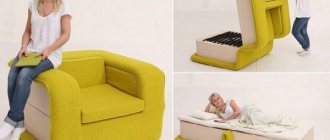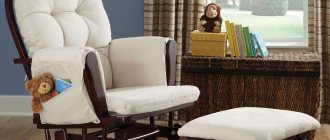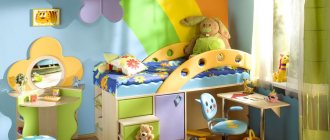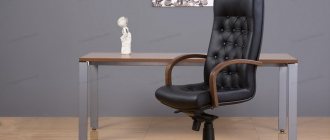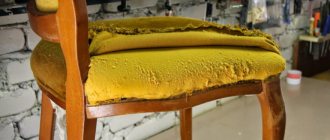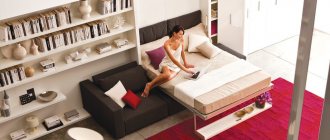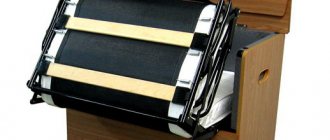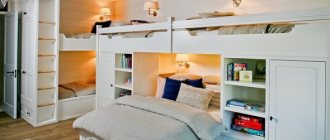What does the chair-bed consist of?
In general, there are several varieties of the described device. However, each of them has those components that are similar to each other. Thus, the following aspects can be highlighted:
- Frame. It is also possible to consider in several proportions. By choosing steel material, the user is assured of durable operation. If we talk about aluminum, it is very important to emphasize its inherent qualities such as reliability and guaranteed strength.
ATTENTION! However, the product is not suitable for daily use. As for wood, special conditions for use are required. This includes not only a certain temperature, but also a special humidity indicator.
- Folding mechanism.
- Bed.
- Filler. When choosing it, it is recommended to place special emphasis.
- Linen box. Often, manufacturers equip the design with such a product, which adds additional positive aspects.
How does a chair bed function?
The answer to the question directly depends on the model of the bed. Thus, the following can be highlighted:
- Eurobook. The process takes place by pulling out the lower part of the furniture. Due to this, it becomes possible to expand the other part.
- Harmonic. Two sections fold out to reveal a third that functions as a seat.
- Roll-out mechanism. The name speaks for itself. The inverted base forms two sections.
- Click-clack. The main part rises, which means the blockage is removed and a solid mattress is formed.
- Dolphin. The part that folds out is located under the base; after it is pulled out, it transforms into a regular sofa.
DIY folding beach chair with gas lifts + drawing
Hello, dear readers and DIYers!
Surely many of you love to relax in the forest, on the beach or just at your summer cottage. However, with a cozy chair, relaxation becomes even more comfortable. In this article, Ivan, author of the YouTube channels “HandCraft” and “Creates DIY,” will tell you how he made a folding chair from scraps of plywood sheet.
This project is not very difficult to make, and with some simplifications it can be made with a minimum set of tools.
Materials. — Gas elevators (100N) for furniture — 18 mm thick plywood sheets, boards — Door hinges, wood screws — Sandpaper, PVA glue, wood impregnation, Whatman paper, masking tape.
Tools used by the author. — Clamps — Circular saw — Grinder, disc sander — Screwdriver, wood drills with countersink — Self-centering drills, magnetic bits — Spade drills for wood — Furniture stapler — Hand router — Set of wood cutters — Quick-release clamp for a workbench — Lathe, reyer, meisel, hacksaw for metal - Electric jigsaw - Hand-held circular saw - Digital square, automatic core - Carpenter's vice, pencil, compass, square, ruler, knife, scissors, hammer, brush. Manufacturing process. So, the main material for the chair will be scraps of sheet plywood 18 mm thick. The author sets the parallel fence of the circular saw at a distance of 25 mm from the edge of the saw blade.
After this, the plywood is unraveled into long slats. From these the master will glue a large panel together to obtain a spectacular pattern. Although it is quite possible to do without this procedure by making a chair from a plywood sheet.
The resulting blanks are laid out with cuts close to each other on three long clamps. A layer of PVA glue is applied to the top surface and leveled with a brush or roller.
The author should have placed plastic film between the boards and the shield so that they would not stick. Therefore, I had to use a hammer to remove them. Traces from glue drips have also formed on the lower part of the shield; the master processes both surfaces with a grinder with a disc sanding attachment.
To mark the pattern, the author needed to secure a couple of sheets on a workbench with a furniture stapler and glue them together with masking tape. When marking different angles, it is convenient to use a digital square.
The result is a pattern like this, designed for half a chair, along its central axis. The pattern is cut around the perimeter, and a segment is also removed from the central part.
Then the pattern is turned over, the edges of the lines are aligned, and the second half is outlined.
Excess material from the outside is cut off with an electric jigsaw.
In order not to spoil the edges of the parts, when drilling holes for the jigsaw blade to enter, the author cuts out internal straight lines using a hand-held circular saw. This tool allows you to plunge the saw blade directly into the thickness of the material.
As a result, the master came up with 5 blanks for the back, seat, armrests, and front leg.
Complex internal curves and external edges are sanded by hand with sandpaper. As a result, you get this contrasting pattern at the ends.
Now the workpieces are fixed one by one on the workbench with a special clamp, and all edges are rounded using a hand router using a radius cutter with a thrust bearing. By the way, Ivan made this clamp himself. Its production is described in detail in a recent article.
Eight small door hinges are required to connect the structural elements. Two pairs of them will connect the seat and armrests to the back.
To accurately mark the centers for the pilot holes, the author uses an automatic core punch. Then the holes are made with a wood drill with a countersink. Then the furniture hinges are screwed into place in the lower part of the backrest.
Of course, the operation of drilling pilot holes can be performed much easier and more accurately with self-centering drills.
Pilot holes are marked and drilled for the screws, and the fasteners are screwed into place.
The part is fixed in a carpenter's vice, and a notch is made according to the markings for fastening with an end mill. In this case, the master uses a side stop on a manual router.
First, the master snaps the piston heads onto the mounts.
The housing shanks also snap into place.
Gas elevators do their job perfectly, raising the backrest almost vertically.
The author also decided to make the legs for the chair himself, although store-bought rubber ones would have been quite suitable. He cut out several squares of plywood and glued them together. After the glue has dried, the workpiece is fixed on a lathe and turned to a cylindrical shape using a reamer.
The master gives a rounded shape to the edges of future legs using meisel.
The blanks are cut with a hacksaw, and holes for self-tapping screws are drilled into them.
All that remains is to screw the legs into place, after applying a little glue.
Now the back is connected to the back of the armrests with loops.
The remaining four hinges will connect the front parts of the seat and armrests with the combined part of the chair.
To protect the wood from moisture, the author impregnates the surfaces of the product with linseed oil. Of course, it is advisable to do this before assembly, because oil will not get under the hinges and fastenings.
After a few hours, excess oil is removed, and the author checks it in operation.
He also made a cutout at the top of the back for easy carrying. When folded, this chair is almost flat and easily fits in the trunk of a car.
And the chair opens on its own, you just need to slightly raise the backrest.
I thank Ivan for the idea and implementation of the simple design of a folding beach chair!
Good mood, good health, and interesting ideas to everyone!
The author's video can be found here.
Source
Become the author of the site, publish your own articles, descriptions of homemade products and pay for the text. Read more here.
Required Tools
What you will need:
- washers;
- 8 pieces of screws;
- 2 springs;
- 2 plugs;
- nuts;
- screwdriver;
- screwdriver
Step-by-step instructions on how to assemble a chair-bed
Follow the following sequence:
- It is advisable to first keep the parts in a warm room for at least two hours.
- Make room and prepare the necessary items.
- Place the packaging materials on the floor and unpack the products.
- Install the brackets on the sides and secure with screws and washers.
- Fix the supports and attach the nuts. Do the same with checkboxes.
- After which you can begin installing the drawer. For this you will need fastenings.
- The spring and plug should also be secured.
- Secure the sides to the mechanism with screws.
- Attach the backrest and make sure the structure is secure.
How to install a chair-bed correctly
When choosing a place that is suitable in your opinion, you should take into account not only personal preferences, but also adequately assess the situation. Thus, the size of the structure itself also influences the result.
REFERENCE! Naturally, it is recommended to choose the position directly under the structure in the unfolded version. And this is understandable, because when assembled, the furniture takes up less space. As a result, the device should not be in the way in the room, and its disassembly should not be complicated.
Simple DIY chair-bed
A chair-bed is the optimal solution for small spaces, as well as in case your guests want to stay overnight. This chair does not take up too much space, but will perfectly replace a full-fledged sleeping place.
The mattress is made up of homemade flat pillows: the base of the seat and two pillows for the back. The chair is equipped with a drawer for bed linen. It folds and unfolds easily. To build such a chair-bed with your own hands you do not need any special professional skills - even a beginner can cope with the task.
So, the chair consists of two parts, fastened together with ordinary one-piece metal hinges. Let's see what we need to make a chair-bed ourselves.
Materials:
– 8 boards of the same length for making the frame of a chair-bed; – 8 strips to strengthen the frame in the corners; – slats for the base of the chair, on which the pillow will rest; – slats and two strips for making a base board for the second part of the chair; – plywood panel – the bottom for the main part of the chair; – three pieces of furniture foam rubber 100 mm thick: two narrow for the back and one wide for the seat; – any suitable fabric for pillows; – furniture screws or ordinary wood screws; – furniture glue if desired; – any product for protective and decorative treatment of wood; – furniture varnish if desired; - nails; – metal one-piece hinges: large for connecting two parts of the chair-bed and small for fastening the shield in the bedding compartment.
Tools:
– hand-held circular saw or jigsaw; - Miter saw; – vibrating or orbital sander; – drill and wood bit; – screwdriver; – construction tape; – clamp for drilling at an angle; - pencil, square.
Step one: selection and preparation of materials
To make a chair-bed, you will need boards with a thickness of at least 30 mm and slats of suitable cross-section for the base of the pillows. Replace the plywood - the bottom of the bed linen box - with a sheet of fiberboard or chipboard if desired. Prepare 8 pieces of wood to reinforce the chair-bed frame in the corners.
Unusual and simple chair-bed
At its core, our chair-bed is a chair-mattress. Since it does not have a rigid base, the backrest should be placed against the wall. These are three soft identical pillows, which form an original chair 60 cm wide, 40 cm deep, 30 cm high. The back height is also 30 cm.
Advantages, or why it is worth making such a chair:
- lightweight, there are no wooden or heavy metal parts;
- mobile – even a child can move the chair;
- practical - if the product gets dirty, you can clean it or remove the cover and wash it;
- inexpensive;
- a convenient place for relaxation and children's games.
a) general view of the chair-bed when assembled; b) the principle of folding parts of the product; c) a visual demonstration of how the pillows are laid out:
- 1 – back;
- 2 – strap;
- 3 – strips of fabric that connect the pillows;
- 4 – lower part of the seat;
- 5 – middle part;
- 6 – upper;
- 7 – buttons.
What will be useful at work
- Durable main textile.
- Textile for connecting pillows can be a less expensive but durable material.
- Polyurethane foam or latex at least 10 cm thick for filling pillows. You need to cut it yourself: 1 piece. – 50x60 cm, 3 pcs. – 40x60 cm.
- Straps, buttons.
- Sewing machine.
- Zippers 60 cm long.
Description of work
- We sew a cover for a pillow 50x60x10 cm and three parts for the base of a soft chair-bed 40x60x10 cm.
- Strips of fabric will serve as furniture hinges. Cut strips 60 cm long. Finish the edges with an overlocker or another method that does not allow the fabric to lose strength. Connect the cushion covers in pairs with stripes, as shown in the diagram. For this purpose, you can use detachable zippers. This will make it easier to care for textiles.
- We sew straps to the side edges, and buttons to the sides of the upper part of the seat, respectively. They are needed for additional fixation of the backrest in a vertical position.
In order to prepare the chair-bed for sleeping, you should unfasten the straps, then pull the top pillow towards you. The length of the mattress is 170 cm. This sleeping place is suitable for a child or a short adult. If you want to make a longer mattress, you can independently adjust the parameters of the pillows before cutting.
DIY chair bed: drawings and manufacturing diagrams
If you make a chair bed with your own hands, you can not only save a lot of money, but also get at your disposal an interior item of the desired design, color and size. Purchased products do not always differ in the quality of workmanship and materials used. Personally assembled furniture will meet all the criteria of environmental friendliness, convenience and reliability. To carry out this process, you will need a little free time, a set of household tools and the ability to use them.
DIY chair - simple step-by-step instructions from design to decoration (115 photos)
You can buy any thing in modern stores. With a little imagination, a mouse and keyboard with Internet access, your computer will be flooded with a huge number of offers from social networks and online stores. It also happens that the financial situation is not the best, and purchases in online stores are considered elements of luxury. And sometimes you just want to do something with your own hands, they just itch. Here we have a small selection of examples of how you can make some furniture with your own hands.
Brief contents of the article:
Deciding on design and construction
Before you start making a folding chair bed, decide on its design.
Important! When choosing a design, factors such as convenience and safety of operation of the product and ease of maintenance should be taken into account.
There are such types of designs of this furniture:
| Frame. | It is a wooden base onto which the soft part is attached. The parts are connected to each other with hinges; rollers can be used. The finished product is heavy and stable. |
| Frameless. | It consists of several fastened pillows that transform into a full-fledged sleeping place of the 60-80 cm standard. Due to the absence of armrests and a rigid base, the seat can be easily unfolded without clinging to the sides, has a low weight and compact size. |
Drawings and diagrams
To properly make a chair bed with your own hands, the drawings of each detail must be carefully thought out and checked. It is necessary to provide for all the nuances, including the installation location, the presence of furniture nearby and the procedure for cleaning soiled upholstery. Thus, frameless models when folded should be close to the wall so as not to tip over backwards
The dimensions of the bed chair can be arbitrary, but the dimensions (width, height, length) should be calculated for an adult.
The recommended data is as follows:
- thickness of the soft part – 10 cm;
- length when unfolded – 190 cm;
- width – 60-80 cm;
- Seat height when folded is 35-45 cm.
The diagram shows the following elements of upholstered furniture:
- frame in detail;
- loops;
- guides;
- legs;
- armrests;
- folding mechanism;
- patterns for covers.
Based on the drawing, calculations are made of the tool needed for the job.
Classic chair-bed
Making a chair-bed with your own hands is quite easy. The main thing is to first understand the sequence of work. The classic frame design is designed for its intended use. In other words, you can sit in a chair during the day and sleep at night. This is an ideal option for a person who lives alone in a small apartment. This model can be described as “three in one”. This is not only an armchair and a bed, but also a chest of drawers. After all, the bottom of the structure can be used to store bed linen, blankets, etc.
Before doing the work, you need to prepare a diagram for assembling the future chair-bed with your own hands. The drawings will help you immediately assemble the structure according to a well-thought-out plan. The base of the structure will be a simple bench with cushions, and behind the back of such furniture there will be shelves with doors. Do-it-yourself drawings and diagrams of a chair-bed can be done quickly. They should include not only a schematic representation of the future product, but also a list of materials.
To make the structure you should prepare:
- PVA glue;
- Chipboard 20 mm thick;
- screws, nails, wooden spikes;
- hardboard sheet for the bottom;
- foam rubber for soft upholstery;
- construction staples;
- textile.
The pattern is ready, now you can start making patterns for future upholstery. You can use ready-made foam pillows and sew them together. To fix upholstery fabric, it is better to use construction staples or furniture nails.
If desired, you can also make armrests. Experienced craftsmen know that soft armrests are not practical. It is better to make them yourself from wooden blocks or metal pipes.
Required materials and tools
The question of how to make a chair bed with your own hands should be approached creatively, but economically. In the apartment and at the dacha you can find the necessary materials and equipment.
To assemble upholstered wooden furniture you will need the following tools:
- roulette;
- stationery knife;
- hacksaw;
- plane;
- square;
- electric drill;
- screwdriver;
- construction stapler;
- scissors;
- marker;
- sewing machine.
To make a folding chair with a soft part made of foam rubber, the following materials are needed:
- wooden beam;
- chipboard;
- plywood;
- PVA glue;
- acrylic paint or wood varnish;
- sandpaper;
- screws;
- bolts with nuts;
- upholstery fabric;
- metal loops;
- detachable zippers;
- rollers.
This is a short list of necessary accessories. Hardware for connecting parts of the chair into a single structure can be purchased in specialized stores.
Attention! Buy upholstery material that is dense and strong. It should last for many years, subject to constant mechanical stress and regular washing.
DIY bean bag chair
In the first example, we will look at the production of frameless furniture; the most popular thing in stores today is a beanbag chair. A photo of the DIY chair is presented below.
The materials cost for one bean bag chair is $40. This includes: polystyrene balls (filler), inner cover, outer cover.
First, the inner cover is sewn and filled with foam balls, then the outer one. Then we simply insert the inner cover into the outer one and we get a finished chair bag.
The hardest thing is to collect the balls in the bag, they keep trying to jump out of it, I had to use a vacuum cleaner. This is a brief instruction on how to make a beanbag chair with your own hands.
Manufacturing process step by step instructions
If working at home, prepare a spacious area for assembly. If possible, it is better to carry out sawing and polishing in a separate room or outdoors. If this cannot be done, then you should take the flowers out of the room and cover the furniture with construction film to protect it from dust and sawdust. When working with wood and a stapler, it is recommended to use assembly gloves to avoid rubbing calluses and to avoid splinters getting into your hands.
Important! During the assembly period, it is better to remove pets and children from the room, as they could be injured by the sharp edges of the tools or damage something.
Case manufacturing
It’s better to make the chair frame with someone, but you can do it yourself. An assistant will be needed when connecting the vertical and horizontal parts.
Housing assembly sequence:
- Based on the calculations and diagrams, the components of the frame are cut out and polished - vertical posts, middle slats, railing parts, bases for the seat and backrest.
- The sides are assembled using furniture screws. Their mirror compliance in all parameters is checked. If these parts are open, then balusters are inserted. The closed type product is sheathed on the sides with plywood.
- The backrest is attached to the rear pillars. Its size corresponds to the parameters of the seats.
- Guides are installed for the movement of the rollers. These pieces will serve as the base for the pillows.
- The bottom of the box is covered with plywood, and its top is covered with a hinged lid.
After checking the compliance of the dimensions with the calculated data, the structure is reinforced with transverse bars.
Installation of the mechanism
Products with a folding mechanism are convenient to use. Thanks to this device, the pillows are firmly fixed in the desired position. When purchasing a part, be sure to obtain installation instructions from the seller.
The frames of the base and seats are fixed in a given position. For this purpose, supports and tape are used. To be sure, it is better to take thin and long screws. When the structure is fixed, you need to attach both parts of the mechanism to it and make marks for drilling. After making the holes, the parts are bolted and lubricated at friction points.
Before further assembly, it is recommended to check the correct installation of the transformation mechanism. It should work gently, without any effort.
Sheathing
You should start by making patterns. It is advisable to first design the process. It is better to do this using two sheets of A4 paper. The canvas and parts that will be used for upholstery are cut to scale. After this, the optimal option for cutting the material is determined by trial. From the resulting patterns, covers are sewn with an allowance of 3 cm for fastening.
Then the side parts are finished. They are covered with 20 mm thick foam rubber. Fastening with brackets is carried out on the lower part.
100 mm foam rubber or 2 layers of 50 mm each are glued to the seat base. When the glue dries, the cover is pulled over the pillow. Nailing is carried out in the direction from the centers to the edges.
Decorating a bed chair
To give the finished product an original and stylish design, the following decoration options are used:
- embedding spotlights into the façade sidewalls;
- armrest trim with LED strips;
- covering with tapestries or embroidery;
- sewing appliques to covers;
- gluing mosaics to legs and balusters.
If time and opportunity permit, you can sew several replacement covers for all occasions. This option will allow you to quickly remove dirt or choose decor to suit your mood.
Almost classic furniture
The proposed chair-bed is such simple furniture that you simply won’t need drawings. Such furniture can always be offered to a guest for sleeping. Traditional materials - wood, plywood, polyurethane, textiles - make it a reliable support for many years.
Materials and tools
- For the production of the frame (backrest, railings, seat base) high-quality sheet plywood and boards will be used.
- Glazing beads.
- Saw.
- Furniture hinges.
- Self-tapping screws.
- Screws with nuts.
- Electric drill, drill bits.
- Wood glue.
- Grinding machine with attachments of different grain sizes.
- Varnish or paint for finishing.
The dimensions of the parts can be selected independently depending on personal preferences and capabilities.
Description of work
- First of all, we assemble the sides of the chair. The frame consists of parts:
- vertical racks, the lower part of which will serve as legs;
- three middle bars;
- bottom crossbar;
- railing
Before assembly, the components should be processed: remove roughness, smooth out corners. Drill holes for glazing beads in the lower part of the railing, lower crossbar, and vertical elements. Connect the structure with glazing beads and glue. The main thing is to prepare the same parts for the right and left parts so that they are mirror identical.
- Glue the decorative strip to the railing, moving it 2-3 cm to the front.
- Attach the bars to the bottom crossbar of the inside of the railing with self-tapping screws. This is where the base for the seat will be mounted.
- The back of the chair can be made in a similar way, but completely symmetrical and without legs. That is, the lower crossbar is installed at the ends of the side ones. The back of the chair will not be installed on the floor, but higher, so you don’t have to increase the height of the parts.
- Measure the length of the lower back. This size is the side for 3 identical squares that form the base and the fold-out bed. We make the side parts from bars, the bottom from plywood. For structural rigidity, we install additional bars in the middle of each box. All connections are made with self-tapping screws.
- We install hinges on the boxes, 2 for each connection, so that when unfolding we get a smooth surface.
- We lay the folding parts between the sidewalls. We fasten the bottom box with 4 screws to the sides, as can be seen in the photo.
- Install the backrest of the folding chair. The bottom edge of the backrest should be just above the edge of the top box. Thus, this part will not suffer from unfolding/folding, and will not interfere with transformation.
- Measure the height of the chair legs. You need to decide whether the legs will be on a folding part with a folding mechanism or made separately and attached.
- Cover the surface of the chair with varnish or paint, depending on which finishing method suits you best.
How to make a new chair-bed more comfortable with your own hands is up to you. You can decorate it with many beautiful pillows or equip it with a bright, tri-fold mattress.
DIY chair bed: drawings and manufacturing diagrams
If you make a chair bed with your own hands, you can not only save a lot of money, but also get at your disposal an interior item of the desired design, color and size. Purchased products do not always differ in the quality of workmanship and materials used. Personally assembled furniture will meet all the criteria of environmental friendliness, convenience and reliability. To carry out this process, you will need a little free time, a set of household tools and the ability to use them.
DIY home chair
Now let's look at making a regular home chair with our own hands. Unfortunately, there were quite a few photographs; there was no time to take photographs. The main stages were recorded in a timely manner, switching from a tedious workflow.
I wanted to get an ordinary chair, and not just some incomprehensible rookery. So that it is strong and stable, like store-bought options. I had to look on the Internet for views and drawings of chairs in order to correctly assemble my design. I suggest you immediately look at the photographs of the chair assembly process itself.
At the first stage, a base-frame for the future chair in the form of a semicircle is made. Chipboard with timber is used. The base of the chair was 10 centimeters thick. This will be just enough to secure the walls. And the uprights have the same ultimate function.
Hardboard was perfect for the back, and plywood for the front wall. I drew out all the curves and outlines of the future chair by eye from the remaining wallpaper. Children's wooden cubes were used for the base.
The next step was to glue cardboard to fill the interior space. During the work, we even had to change the glue; the initially chosen PVA did not work. The walls swelled and became like a wafer, the glue was replaced with ordinary wood glue. It turned out to be the best choice of all that was offered. There was even an idea for a rocking chair with my own hands, but I will implement the idea a little later.
After looking at the photo, you can immediately easily understand how the finished walls were obtained. For leveling I used a regular knife; the material is easy to cut and can be deformed.
At the next stage, work with instant adhesive and foam rubber, seal the entire surface with a layer of foam rubber, leaving no bald spots or uncovered areas. A cover must be sewn onto a monotonous surface.
Well, we have reached the final stage, when we pull on the cover and get a beautiful finished chair. The product turned out to be quite heavy, but it will be completely safe for children, which can be considered a plus. As for the fabric used, nothing was bought anywhere. We used scraps and sewing scraps available at home.
We wanted temporary furniture; no one planned to make a chair that would last forever. The fabric on the armrests, despite being well tacked with glue, will peel off over time. If we say a little about the design of the chair, it turned out to be simply indestructible.
Deciding on design and construction
Before you start making a folding chair bed, decide on its design.
Important! When choosing a design, factors such as convenience and safety of operation of the product and ease of maintenance should be taken into account.
There are such types of designs of this furniture:
| Frame. | It is a wooden base onto which the soft part is attached. The parts are connected to each other with hinges; rollers can be used. The finished product is heavy and stable. |
| Frameless. | It consists of several fastened pillows that transform into a full-fledged sleeping place of the 60-80 cm standard. Due to the absence of armrests and a rigid base, the seat can be easily unfolded without clinging to the sides, has a low weight and compact size. |
Drawings and diagrams
To properly make a chair bed with your own hands, the drawings of each detail must be carefully thought out and checked. It is necessary to provide for all the nuances, including the installation location, the presence of furniture nearby and the procedure for cleaning soiled upholstery. Thus, frameless models when folded should be close to the wall so as not to tip over backwards
The dimensions of the bed chair can be arbitrary, but the dimensions (width, height, length) should be calculated for an adult.
The recommended data is as follows:
- thickness of the soft part – 10 cm;
- length when unfolded – 190 cm;
- width – 60-80 cm;
- Seat height when folded is 35-45 cm.
The diagram shows the following elements of upholstered furniture:
- frame in detail;
- loops;
- guides;
- legs;
- armrests;
- folding mechanism;
- patterns for covers.
Based on the drawing, calculations are made of the tool needed for the job.
Required materials and tools
The question of how to make a chair bed with your own hands should be approached creatively, but economically. In the apartment and at the dacha you can find the necessary materials and equipment.
To assemble upholstered wooden furniture you will need the following tools:
- roulette;
- stationery knife;
- hacksaw;
- plane;
- square;
- electric drill;
- screwdriver;
- construction stapler;
- scissors;
- marker;
- sewing machine.
To make a folding chair with a soft part made of foam rubber, the following materials are needed:
- wooden beam;
- chipboard;
- plywood;
- PVA glue;
- acrylic paint or wood varnish;
- sandpaper;
- screws;
- bolts with nuts;
- upholstery fabric;
- metal loops;
- detachable zippers;
- rollers.
This is a short list of necessary accessories. Hardware for connecting parts of the chair into a single structure can be purchased in specialized stores.
Attention! Buy upholstery material that is dense and strong. It should last for many years, subject to constant mechanical stress and regular washing.
Tools and materials
To make upholstered furniture, one set of tools and accessories is almost always used, and the differences are only formal:
- Jigsaw.
- Screwdriver (drill).
- Sander.
- Milling machine (extremely rare).
- Roulette.
- Square.
- A simple pencil.
- Sewing machine.
- Chalk.
- Scissors.
- Stapler.
The set of materials is more modest, but you need to treat it more carefully:
For upholstery you will need foam rubber.
- Chipboard is used to form longitudinal elements of any width that can be manufactured. For furniture, a board of medium thickness but maximum density is usually used. If there are open areas, then you need to take a laminated version (chipboard), which also avoids negative toxic effects. The disadvantages include fragility, non-environmental friendliness and limited design development, while the price puts the material in 1st place in terms of demand, so this particular material will be given.
- Furniture board is used in exactly the same way as chipboard, but has increased strength characteristics, and at the same time a wonderful appearance. The only disadvantage of the material is its high price, which is why it is used only in open areas.
- Edged board - strength depends directly on the type of wood used, but working with it is quite difficult due to its physical parameters. It is easy to process, especially in cases with tangential cutting. It is usually used as an additional material, although sometimes (under light loads) it serves as a replacement for laminated chipboard and furniture board.
- The beam is a supporting and supporting system. Usually its presence is almost imperceptible, but without it, few designs will be reliable.
- Foam rubber and batting are fillers for upholstery work. It is more convenient to use batting for a chair.
- Spunbond - covers the filler, thanks to which the latter is clearly fixed. Spunbond is also convenient when stretching outer upholstery, because... Provides excellent gliding.
- Upholstery materials can be extremely different, but all have high strength and wear resistance, so that even after 10 years they retain an appearance as close as possible to the original one.
- Small technical and suture fittings.
Manufacturing process step by step instructions
If working at home, prepare a spacious area for assembly. If possible, it is better to carry out sawing and polishing in a separate room or outdoors. If this cannot be done, then you should take the flowers out of the room and cover the furniture with construction film to protect it from dust and sawdust. When working with wood and a stapler, it is recommended to use assembly gloves to avoid rubbing calluses and to avoid splinters getting into your hands.
Important! During the assembly period, it is better to remove pets and children from the room, as they could be injured by the sharp edges of the tools or damage something.
Case manufacturing
It’s better to make the chair frame with someone, but you can do it yourself. An assistant will be needed when connecting the vertical and horizontal parts.
Housing assembly sequence:
- Based on the calculations and diagrams, the components of the frame are cut out and polished - vertical posts, middle slats, railing parts, bases for the seat and backrest.
- The sides are assembled using furniture screws. Their mirror compliance in all parameters is checked. If these parts are open, then balusters are inserted. The closed type product is sheathed on the sides with plywood.
- The backrest is attached to the rear pillars. Its size corresponds to the parameters of the seats.
- Guides are installed for the movement of the rollers. These pieces will serve as the base for the pillows.
- The bottom of the box is covered with plywood, and its top is covered with a hinged lid.
After checking the compliance of the dimensions with the calculated data, the structure is reinforced with transverse bars.
Installation of the mechanism
Products with a folding mechanism are convenient to use. Thanks to this device, the pillows are firmly fixed in the desired position. When purchasing a part, be sure to obtain installation instructions from the seller.
The frames of the base and seats are fixed in a given position. For this purpose, supports and tape are used. To be sure, it is better to take thin and long screws. When the structure is fixed, you need to attach both parts of the mechanism to it and make marks for drilling. After making the holes, the parts are bolted and lubricated at friction points.
Before further assembly, it is recommended to check the correct installation of the transformation mechanism. It should work gently, without any effort.
Sheathing
You should start by making patterns. It is advisable to first design the process. It is better to do this using two sheets of A4 paper. The canvas and parts that will be used for upholstery are cut to scale. After this, the optimal option for cutting the material is determined by trial. From the resulting patterns, covers are sewn with an allowance of 3 cm for fastening.
Then the side parts are finished. They are covered with 20 mm thick foam rubber. Fastening with brackets is carried out on the lower part.
100 mm foam rubber or 2 layers of 50 mm each are glued to the seat base. When the glue dries, the cover is pulled over the pillow. Nailing is carried out in the direction from the centers to the edges.
Decorating a bed chair
To give the finished product an original and stylish design, the following decoration options are used:
- embedding spotlights into the façade sidewalls;
- armrest trim with LED strips;
- covering with tapestries or embroidery;
- sewing appliques to covers;
- gluing mosaics to legs and balusters.
If time and opportunity permit, you can sew several replacement covers for all occasions. This option will allow you to quickly remove dirt or choose decor to suit your mood.
How to update an old chair: 3 master classes and 25 ideas
An old chair can be completely restored or partially updated by reupholstering it or painting the upholstery. How to do this - see our selection of master classes and ideas.
Repainting the upholstery of a chair: master class
One of the easiest and most unexpected ways to update an old chair is to repaint its upholstery. This option will help if the upholstery is not damaged, but, for example, you need to hide stains or just want to change its color. You can repaint the upholstery using paint from a can or can. Choose universal paint or acrylic for fabric, and before starting painting, you can apply a layer of special primer. You can find paint and primer at hardware, art and craft stores. The bonus of such an alteration is that the upholstery treated with paint acquires not only a new color, but also water-repellent properties, and stains from it can most often simply be removed with a damp cloth.
You will need:
- fabric paint;
- a large brush for covering wide surfaces and a small brush, which is more convenient for painting edges;
- container for mixing paint;
- spray bottle with water;
- if desired - masking tape, which can be used to protect the wooden parts of the chair from paint getting on them, and you can do without a primer).
1. First, remove the cushions from the chair. Clean off all the dust, wipe the upholstery with a damp cloth; if there are significant greasy stains, it is better to treat them with a stain remover so that they do not prevent the paint from laying flat.
2. If you wish, coat the surface of the chair with primer. You can do without it. In this case, first saturate the upholstery with water by spraying it with a spray bottle. Don't forget the chair cushion(s). While the upholstery is still wet, dilute some paint with water in a 1:1 ratio and saturate the upholstery with this mixture. This step is especially important if the upholstery of your chair is made of thick fabric. Before painting, you can protect the wooden parts of the chair with masking tape.
3. When the first layer is completely dry, you can begin the second. This time cover the chair with undiluted paint. Carefully brush over all corners, painting all the necessary areas of the upholstery.
4. After the second layer has dried, evaluate how tightly it covers the upholstery. If necessary, add another layer - three is usually enough.
5. If you wish, you can decorate the finished chair with decor by placing it on glue. Ready!
Painting furniture: 5 main rules and master class
More ideas for re-upholstered chairs:
How to quickly sew a chair cover
How to reupholster a chair: master class
This method is, of course, more complicated than repainting. However, by reupholstering, you can almost completely renew an old chair, getting rid of holes and scuffs and getting an almost new piece for your interior.
You will need:
- fabric for upholstery (choose durable, dense fabric);
- sewing machine and threads;
- furniture stapler and staples for it;
- braid for decoration;
- a screwdriver to remove staples from the upholstery of an old chair.
1. Using a screwdriver, carefully remove the staples securing the upholstery parts to the chair. The removed parts will serve as patterns for new upholstery parts of the same type. You can remove not all of the upholstery or, if you wish, not remove it at all. Then you will have to take measurements from the chair and make patterns for new upholstery parts.
2. Cut out new upholstery parts from fabric, not forgetting about an allowance of at least 2 cm. Start attaching them to the chair with a furniture stapler, as shown in the photo.
3. The piece for the back of the chair may need to be constructed from several pieces to ensure it fits well on the chair. Having sewn it, attach the part with a stapler to the back, folding the edges of the fabric.
4. Tape and a glue gun will help hide the attachment points of the back part.
5. Finally, sew a new cover for the chair cushion.
Bedspreads and pillows for the garden: 6 tricks and 30 ideas for inspiration
More ideas for upholstered chairs:
Country interior: 7 design tips and 33 ideas for inspiration
How to restore an old “grandmother’s” chair: master class
Several decades ago, such chairs were in almost every Soviet apartment, and in some houses and dachas they have survived to this day. By the way, today such “grandmother’s” chairs, like other items of Soviet design, are again in fashion. No wonder: the design of this chair is simple and durable, it is comfortable, elegant and laconic. In order for an old piece of furniture to decorate your interior, the chair needs to be restored.
Working technology:
1. Remove the wooden parts of the legs and armrests, clean them of old varnish, if necessary, glue them and cover them with several layers of new varnish.
2. Carefully remove the old upholstery fabric. If necessary, replace the foam rubber by attaching it with a furniture stapler.
3. Using the old upholstery pieces, cut out new ones and attach them to the chair with a furniture stapler.
4. Screw on the parts of the legs and armrests.
Source: burdastyle.ru
